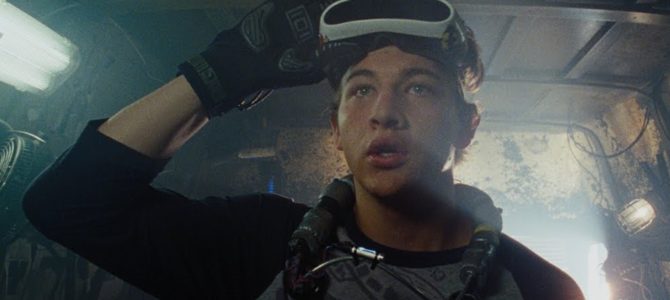
Although set in 2045, “Ready Player One” is so preposterously stuck in the past that it seems targeted exclusively at middle-aged nostalgia-wallowers who stopped listening to new music after Reagan left office. Unfortunately, even they may be put off by the way the film relentlessly and ridiculously exploits every moment-to-remember it recycles, juicing the predictable proceedings with endless drop-ins from decades-ago movies, TV shows and videogames. Viewers haven’t faced a throw-everything-at-the-audience barrage like this since “The Lego Movie.”
Directed by Steven Spielberg, the screenplay by Zak Penn (“X-Men: The Last Stand”) and the novel’s author Ernest Cline attempts to cram in a wildly unlikely number of 1980s pop-culture references and radio hits. The excuse is that deceased videogame creator James Halliday (a dithering Mark Rylance) was so enamored of the era that he filled his virtual reality game known as the OASIS with tidbits from that time.
The basic plot, which is stretched to 140 minutes despite being so slight it could have appeared as an episode of Spielberg’s surprisingly lousy 1980s TV series “Amazing Stories,” involves a trailer-dwelling 20-something trying to win the game. Aided by fellow spunky outcasts and opposed by an evil corporation with vast resources, he shoots and scores. That means much of this movie is the equivalent of observing somebody else hog the controls to play a videogame while you watch.
What’s even more contrived than the idea that Halliday was so fanatically obsessed with the ’80s is that any of the film’s youthful protagonists still would enjoy or care about songs like Van Halen’s “Jump” or George Michael’s “Faith,” movies like “Back to the Future” and “Buckaroo Banzai,” or ancient Atari videogames. Could the OASIS game really achieve massive popularity despite everything in it being so dated? For comparison, I doubt that many of today’s college kids are into Domenico Modugno’s “Volare,” “South Pacific” or rolling barrel hoops down Main Street with a stick.
Spielberg obviously isn’t the first filmmaker to jukebox a flick with existing hits in the hope of gaining affection by association, but the idea that anyone in 2045 would still recognize and get happy feet for “Stayin’ Alive” is simultaneously cynical and depressing.
Dead-eyed and distracted Tye Sheridan (Scott Summers/Cyclops in “X-Men: Apocalypse”) stars as Wade Watts, a no-visible-means-of-support man-child who lives with his aunt and whose role-playing alias is Parzival. His narration hinders the movie in the same way as when characters later give each other wordy explanations of plot points. Because all scenes that take place in the virtual-reality game are CGI, much of his performance (and that of other cast members) consists of giving voice to his animated avatar there.
The animation is undeniably impressive, with a wide variety of imaginative characters, settings and fantasy creatures making up the online OASIS universe. Parzival’s best friend there is a hulking but friendly brute called Aech (pronounced “H”) (Lena Waithe). Parzival soon falls for the motorcycle-riding redhead Art3mis (pronounced “Artemis”), played by Olivia Cooke (“Thoroughbreds,” TV’s “Bates Motel”). They and every other player are looking for three hidden keys that will give the finder control of the OASIS and ownership of the company that runs it.
When Parzival expresses his feelings to Art3mis in the virtual world, she warns him that she doesn’t look like her avatar. Unfortunately, and somewhat offensively, the movie’s idea of what she thinks will make her repulsive to behold is nothing more hideous than a port-wine stain birthmark on her otherwise lovely face. Okay, maybe she actually would be sensitive about that — but when you’re misdirected to wonder if she might be a twisted monstrosity (or even a dude), the revelation is a bit of a letdown.
The villain of the piece is Ben Mendelsohn (“Rogue One: A Star Wars Story”) as Sorrento, head of the IOI corporation that is not above committing real-world murder to get control of the OASIS. He’s so undeserving of that retro-reference-filled game that he can’t even differentiate between the names of schools in John Hughes movies without cheating.
As Parzival and company decipher increasingly obscure clues within the agonizingly endless game, one takes them into a perfect re-creation of the Overlook Hotel from “The Shining.” Watching this scene is akin to hearing an obnoxious rap record whose only redeeming aspect is a sample stolen from a far better song. After thoroughly botching Stanley Kubrick’s dream SF project “A.I.” following the director’s death, was it really necessary for Spielberg to sodomize his corpse once again? (Note: Too harsh?)
Granted, some viewers may regard that scene — and the infinite catalog of other pop-culture callbacks on display here — more as lovingly lighthearted homages than lazily larcenous offenses. They may chuckle in recognition upon hearing the opening strains of “We’re Not Gonna Take It,” spotting TV’s Batmobile, or hearing someone refer to a bygone Tootsie Roll commercial’s spokes-owl.
But “Ready Player One” is essentially a bizarre “things were better back then” attempt to ignore not only the future but also the present by clinging to the past. That makes this doddering throwback feel less current than even “The Matrix,” which was released 19 years ago.
Game over, man. Game over!









